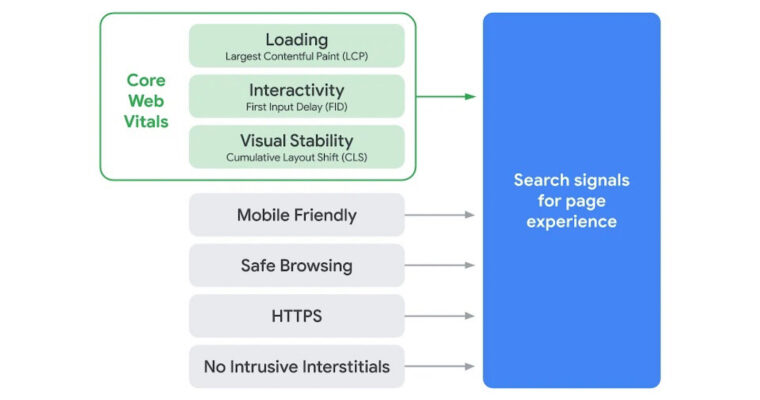Google’s announcement regarding their page experience update and its scheduled roll out has set the marketing world abuzz. But how exactly does it affect you? And what are the expected implications on your business?
It is no secret that the success of a website is largely dependent on its visibility. And this visibility is achieved by ranking high on the SERPs of search engines. Google (which accounts for over 90% of the global search engine market), has a unique algorithm that uses ranking signals to determine the ranking of each website on its results page. One such ranking factor is page experience.
Page experience is a measurement of how users perceive the experience of interacting with a web page which is based on actual user visits. Google’s updated page experience algorithm combines previously known factors such as mobile friendliness and website security, with new signals called Core Web Vitals.

So, how do these factors affect page experience? And what can you do to optimise user experience?
7 Factors Which Affect Page Experience
1. Mobile Friendliness
With over 60% of all website visits originating from mobile devices, it is no wonder that having a mobile friendly site is an important part of the user experience. Some tips for optimising your website to ensure it is mobile-friendly involve:
- Improving your sites loading time-
This directly impacts bounce rates and conversion rates, so having fast-loading pages should always be a priority. Compressing images and minifying code are two ways to achieve this.
- Integrating responsive web design –
Responsive design ensures the images and characters of the webpage adapt to the size and orientation of the device on which it is viewed.
- Constructing thumb-friendly web pages which include legible fonts, easy to click buttons, and easy to use navigation bars.
2. Safe Browsing
Keeping your website safe for users helps maintain regular traffic. Safe browsing requires regular assessment of the website to ensure secure browsing. The assessment detects for malware, phishing, and hacked content. By regular monitoring, updating security measures, and quickly resolving breaches, you can maintain a secure site. This ensures user confidence and loyalty.
3. HTTPS
Hypertext transfer protocol secure is the secure version of HTTP which is used to transfer data between a browser and a website. HTTPS is encrypted thus ensuring secure communication over a computer network. By migrating from a HTTP to a HTTPS, you are showing users that you take web security seriously and make your website far more appealing to users.
4. No Intrusive Interstitials
Intrusive interstitials are essentially pop-ups. They can be especially intrusive when the website is viewed on mobile devices as they tend to block the entire screen. This creates a particularly negative browsing experience. If you have to use pop-ups, use them sparingly. Also make sure that the pop-ups are easy to close. And once closed, they do not pop up repeatedly.
5. Largest Contentful Paint
This factor is one of the core web vitals of the updated page experience algorithm. This essentially measures page loading performance. Or more specifically, the speed with which the largest content element becomes visible. A LCP time of more than 4 seconds is considered to be poor, whereas a LCP of under 2.5 seconds ranks your website as good.
To optimise your website for LCP, you have to work on the issues that commonly affect LCP adversely. These include:
- Slow server and software response times
- Slow resource load times
- Render-blocking JavaScript and CSS code
- Client/browser-side rendering
6. First Input Delay
First Input Delay (FID) is basically a measurement of the responsiveness of your website. The time taken for the website to respond to an interaction with a user. This interaction maybe in the form of a click on a link or a button, or even a question. Ideally, an FID should be less than 100 milliseconds. While those over 300 milliseconds are ranked as poor.
The main reason for a poor FID score is heavy JavaScript execution. To optimise your website to respond faster to user interactions, you could:
- Break down long running code into smaller tasks
- Optimise webpage for interaction readiness
- Use a web worker
- Reduce JavaScript execution time
7. Cumulative Layout Shift
Cumulative layout shift (CLS) is a core web vitals metric that measures the visual stability of a webpage. It quantifies how many times users experience unexpected layout shifts (text, links, or any other visible element moving) that contribute to a negative page experience. A shift in the layout or position causes a disruptive experience, so a CLS score of less than 0.1 is considered ideal.
The factors that contribute towards a high CLS score and thereby, a poor page experience include:
- Dynamically injected content
- Images, ads, iframes, and other embeds without dimensions
- Web fonts that cause invisible text (FOIT)
- Animations that trigger layout changes such as box-shadow
By resolving these elements, you could optimise CLS and provide users with a positive page experience.
What Can You Do to Prepare Your Site?
The first step to optimising for page experience is to evaluate your webpages for the page experience metrics. There are currently 6 developer tools available to measure core web vitals:
- PageSpeed Insights
- Lighthouse
- Search Console
- Chrome UX Report
- Web Vitals Extension
- Chrome DevTools
These tools help identify areas that require improvement so that you can increase the core web vitals score of your web pages in order to deliver exceptional page experiences.
Why Is Page Experience So Important?
With ever-increasing competition between websites to achieve high ranking in SERPs, developing web pages that meet the criteria of Google’s ranking algorithms has never been more important. And although Google uses a variety of factors to determine ranking, giving particular priority to relevant and fresh content, user experience is fast becoming a crucial factor.
For businesses to remain visible, they must adapt their marketing strategies to take into account all of the factors that could elevate their rankings, including page experience.
Furthermore, Google may also apply tags or indicators in their SERPs to indicate pages that provide superior user experience. This could be a deciding factor for users when choosing which pages to visit.
Conclusion
While Google incorporates over 200 factors into determining a website’s value, page experience is becoming an increasingly essential entity as it takes into account how users perceive the experience of interacting with a web page. Failure to adapt your website to meet the requirements could have negative consequences on your websites ranking, and therefore visibility. This, in turn, could lead to reduced traffic and leads.
With Page Experience becoming a key component of Google’s ranking systems beginning mid-June 2021, it is vital that companies prioritise user experience when designing their webpages.
If you are looking to update your website to adapt to Google’s ever-evolving ranking algorithms, contact the team at Serendipity! We specialise in curating creative content as well as creating the ultimate user experience, meeting and exceeding all your SEO needs!





